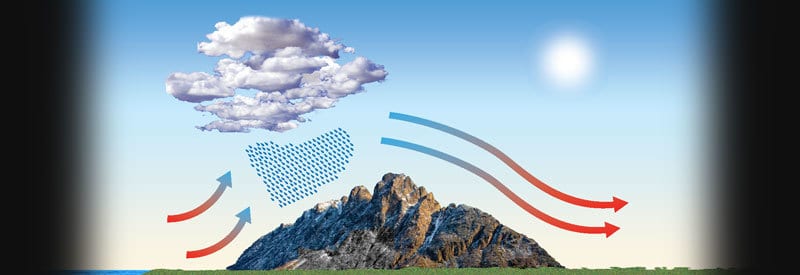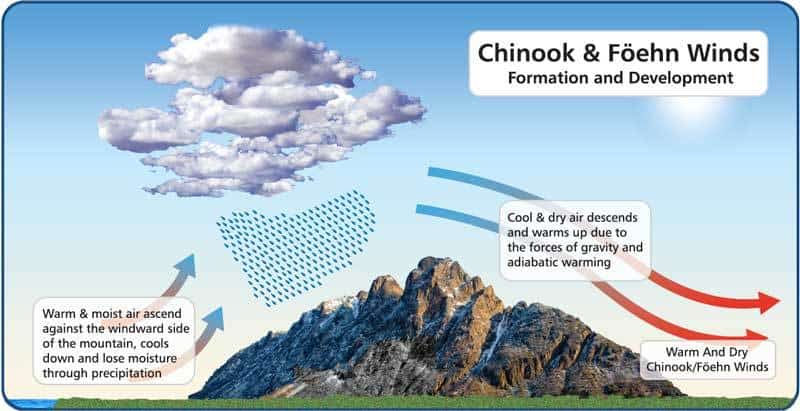Chinook Winds: What They Are And How They Form

Most weather enthusiasts will be unfamiliar with Chinook (or Föehn) winds, but they are simply variations of the same meteorological phenomenon known as the orographic effect. We take a closer look.
Chinook winds are warm, dry winds that blow down the eastern slopes of the Rocky Mountains through a process called the orographic effect. As moist air from the Pacific Ocean rises against the western slopes, it cools & causes precipitation. The dry air warms as it descends down the eastern slopes.
If you live in an area surrounding the region that commonly experiences these winds, you may be familiar with the names. But what exactly are Chinook winds, and how do they develop in the first place?
Chinook winds got their name from the Chinook Native American people who lived in coastal areas near the Columbia River (in the States of Washington and Oregon), where these winds occur on a regular basis.
Föehn winds originate from the German word "Föhn," which literally means hot, dry wind. It is in this region of the Alps in Central Europe where this occurrence was first studied.
Although these winds have different names, depending on the region where they occur, they are exactly the same weather phenomena, no matter where they form in the world.
What Are Chinook And Föehn Winds?
As just stated, the first thing to know about Chinook and Föehn winds is that they are essentially the same type of wind. You may not be aware of it, but the area you live in or one nearby may regularly experience these air movements on a seasonal basis.
By providing a quick summary of what Chinook winds are, and then giving a more detailed description of the Föehn winds they are based upon, one will be able to get a clear understanding of what these type of winds are an how they are created.
What Are Chinook Winds?
Chinook winds (also known as Föehn or Föhn winds) are warm, dry winds that blow down the eastern slopes of the Rocky Mountains through a process called the orographic effect. As moist air from the Pacific Oceans rises against the western slopes, it cools & causes precipitation. The dry air warms as it descends down the eastern slopes.
As already mentioned in the introduction, Föhn (Föehn) winds were first identified and studied in Central Europe's Alps.
The name "Chinook" simply refers to the Native Americans who lived in the region where this phenomenon frequently occurs but are essentially nothing more than Föehn winds.
The process through which a Föehn wind develops follows the same steps, no matter where they are found throughout the world:
How Chinook And Föehn Winds Develop

As moist, warm air blows and reaches the windward side of a mountain, it starts to ascend against the mountain slopes. As it gains altitude, the air also starts to cool down.
Once the air reaches a height where the air has cooled down enough for condensation to take place, precipitation in the form of rain and snow follows. In the process, the air loses most of its moisture, while the condensation also allows for the release of latent heat.
(As contradictory as it may sound, condensation is known as a warming process, and evaporation as a cooling process. To make more sense of these seemingly opposing statements, you can find detailed a more detailed explanation in this article.)
As the air reaches the mountain top, it is now both dry as a result of the precipitation and slightly warmer due to the release of latent heat during the condensation process.
It now starts it descend down the leeward side of the mountain. As the air continues to move downward, the effects of gravity force it to speeds up and become warmer as it continues to accelerate down the slopes towards the bottom of the mountain.
The mass of descending air also has a significant effect on the heating process. As the large volume of air descends, it causes the air to compress. The descending mass of air causes so much pressure that it results in the air heating up, a process called adiabatic heating.
All these steps and processes combined result in a warm, dry wind of considerable strength, known as Chinooks, Föhns.
Regions situated on the leeward side of a mountain experiencing this phenomenon usually experience warmer and more pleasant weather conditions in a cloudless sky.
This process is also commonly known as the orographic effect (or orographic lifting). Find out more detail about this process and how it works in this article.
Effects of A Chinook And Föehn Winds
The warm and pleasant weather experienced by areas in Central Europe parts of Northwest America as a result of these winds is not the only effect they have on the environment.
1) Melting And Evaporation Of Ice
The warm and dry nature of these winds resulted in the name "ice-eaters," due to their ability to melt and even evaporate ice before it can melt. A strong Föehn wind is able to make a layer of 30 centimeters (12 inches) of snow "vanish" within a day.
2) Loss Of Ground Water
The intensity of some Chinook wind occurrences can lead to exposed losing a large percentage of its moisture. It has been reported that wind gusts from a Chinook wind can exceed speeds of 120 km/h (75 mph). This can have a widespread negative effect.
Ingeniousness vegetation naturally will suffer as a result, but it has an even larger impact on the agricultural sector, where crop losses can impact the local economy.
3) Effects On general Health
Several debates are ongoing around the real health effects of Chinook/Föehn winds. It seems the most significant discussion revolves around the issue of whether these winds have a real health impact or are just perceived as such by people who are "affected."
However, there seems to be consensus over the general health effects of this phenomenon. This applies to both the positive and negative impacts of Föehn winds.

On the positive side, the people whose lives are severely inhibited by freezing conditions find their lives easier to manage, as their daily activities are made simpler. Their bodies can cope much better under warmer conditions.
A general feeling of well-being has also been documented, but it's unclear whether it is a result of the relief mentioned in the previous paragraph or if the warmer weather and clear skies directly trigger these emotions.
(The clear skies allow sunlight through, which helps to generate vitamin D in the body, which is responsible for the release of endorphins.)
On the negative side, Föehn winds are connected to the migraines many people are experiencing during the occurrence of this phenomenon. So much so that these migraines are often referred to as Chinook headaches.
Less serious and related effects have also been documented, but many of these have not been substantiated or enough research is done.
Conclusion
After reading this article, the "shroud of mystery" should have been lifted over the foreign-sounding Chinook and Föehn winds.
These winds also have many other names, mostly related to the region where they occur. In South Africa, they are commonly known as a Bergwind, in California the Santa Ana, in Argentina the Zonda winds, and in Slovenia the Fen.
The examples mentioned in the previous paragraph are just a few examples of a number of local names used for the same phenomenon.
So rest assured, the Chinook or Föehn winds you experienced first hand or just heard about are just local names given to a normal phenomenon experienced throughout the world.
Never miss out again when another interesting and helpful article is released and stay updated, while also receiving helpful tips & information by simply clicking on this link .
Until next time, keep your eye on the weather!
